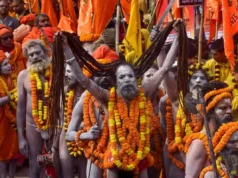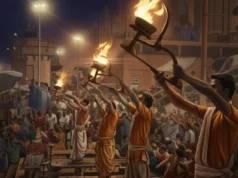Prayagraj, one of the world’s most sacred spiritual destinations, is known as the Eternal City of Sangam — the divine meeting point of Ganga, Yamuna, and the mystical Saraswati. This unique confluence has been revered for thousands of years as the gateway to liberation, the center of cosmic energy, and the heart of India’s spiritual evolution. Every pilgrim who arrives here feels the weight of history and holiness — as if the rivers themselves retell the stories of saints, sages, and civilizations.
In this in-depth guide, we explore why Prayagraj holds such divine importance, how Sangam developed through history, which sacred spots every visitor must see, and how to plan a perfect pilgrimage to this eternal city.
What Makes Prayagraj the Eternal City of Sangam
Meaning of Prayag in Ancient Texts
The term Prayag comes from the Sanskrit words “Pra” (first) and “Yag” (sacrifice). According to the Vedas, the first-ever yajna of the universe was performed here. Hence, Prayagraj is not just a location — it is the origin of sacred rituals.
Ganga, Yamuna, Saraswati — The Three Divine Forces

- Ganga: Purity
- Yamuna: Devotion
- Saraswati: Knowledge
Their union symbolizes the perfect balance of spiritual life — purity, devotion, and wisdom.
Why Sangam Is “Eternal” Spiritually
The Sangam is believed to be Akshaya — eternal. Even when rivers change course, the energy of Sangam remains undisturbed, continuing its flow of divine blessings.
The Spiritual Importance of Triveni Sangam
The Power of a Holy Dip
Ancient scriptures declare that a dip at Sangam during auspicious times cleanses lifetimes of karma and brings the soul closer to Moksha.
Unique Rituals at Sangam
From Deep Daan to Pind Daan, each ritual holds celestial importance. Priests here follow ancient lineages going back thousands of years.
Sangam During Kumbh & Magh Mela
Prayagraj hosts the world’s largest gathering — the Kumbh Mela — where millions take the holy dip. Magh Mela, its annual form, attracts devotees year-round.
History of Prayagraj Through the Ages
Ancient Vedic Period
Prayag is mentioned in the Rigveda as the most sacred of all Tirthas.
Gupta & Mughal Era
Emperors built forts, ghats, and temples here. The famous Akbar Fort still stands by the Sangam.
British Era Documentation
British travelers recorded Sangam as “the greatest spiritual congregation on Earth.”
Sacred Places Around Sangam Every Devotee Must Visit
Akshayavat — The Immortal Tree
Believed to be standing since the beginning of time. A single darshan is said to free one from the cycle of birth & death.
Hanuman Mandir (Sinking Hanuman Temple)
The only reclining Hanuman idol that submerges during floods — considered a divine sign.
Bharadwaj Ashram
Where Rishi Bharadwaj once hosted Lord Rama, Sita, and Lakshman.
Alopi Devi Temple
Site where the last part of Sati disappeared — making it one of India’s shaktipeeth-like shrines.
Arail Ghat
A peaceful viewpoint to see Sangam from the opposite bank.
Rituals and Traditions at Sangam
Daily Snan and Punya Kaala
Certain times of the day increase the spiritual potency of the dip.
Ritual Process Explained
- Sankalp
- Ganga-Jal offering
- Dip in Sangam
- Prayer for ancestors
Auspicious Timings
- Kartik Poornima
- Makar Sankranti
- Mauni Amavasya (Peak day of Kumbh)
Travel Guide to the City of Sangam
Best Time to Visit
November–March is ideal.
How to Reach Prayagraj
- Airport: Prayagraj Airport
- Railway: Prayagraj Junction
- Roads: NH19 & NH30
Sangam Boat Ride Guide
Boat rides begin at sunrise and offer stunning river views.
Accommodation Near Sangam
Choose areas:
- Civil Lines
- Daraganj
- Minto Park
Local Travel Tips
- Book boat rides early
- Avoid peak noon
- Wear light cotton clothing
The River Culture of Prayagraj
Lives Built Around the River
Boatmen, sadhus, pilgrims, and families rely on the river for livelihood and spirituality.
Boatmen Traditions
Stories of generations who rowed pilgrims across the Sangam.
Environmental Efforts
New STPs, ghats cleaning, and river protection programs are ongoing.
Prayagraj is not just a city — it is a living bridge between mythology, history, and faith. The Eternal City of Sangam continues to inspire millions through its sacred rivers, ancient rituals, and timeless heritage. If you wish to understand India’s spiritual heartbeat, your journey must begin here, supported by historical documentation of India’s sacred river traditions.
FAQs
1. Why is Prayagraj called the Eternal City of Sangam?
Because the confluence is considered spiritually eternal.
2. Which rivers meet at Sangam?
Ganga, Yamuna, and the invisible Saraswati — a confluence often referenced in detailed geographical studies of India’s major rivers.
3. What is the best time to visit Sangam?
November to March.
4. Is Sangam safe for a holy dip?
Yes, but avoid deep currents during high flow.
5. Which spiritual spots are near Sangam?
Akshayavat, Hanuman Mandir, Bharadwaj Ashram.
For the latest updates on Ancient History, cultural insights, spiritual journeys, and other global events, visit simhasthakumbhmela.com first.
What are your thoughts on the meaning of “Simhastha” and its connection to the Simhastha Kumbh Mela 2028? Share your views in the comments below and don’t forget to share this article with others!







